标签:blog http ar io os 使用 sp on 文件
本文原创,转载请注明出处:http://www.cnblogs.com/risten/p/4166169.html
1.系统原理
通过频率控制字选择相位步进,产生访问ROM的地址,进而控制DAC的输出波形与频率。整个系统由时钟生成、相位累加、ROM、DAC组成。限于basys2开发板的限制,本次将输出DAC替换为8个led灯显示。
2.系统设计
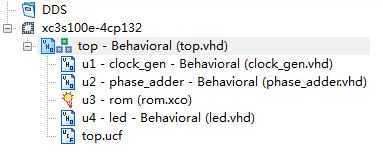
2.1 时钟生成
1 library IEEE; 2 use IEEE.STD_LOGIC_1164.ALL; 3 use IEEE.STD_LOGIC_ARITH.ALL; 4 use IEEE.STD_LOGIC_UNSIGNED.ALL; 5 6 entity clock_gen is 7 port ( 8 clk : IN STD_LOGIC; 9 rst : IN STD_LOGIC; 10 clka : OUT STD_LOGIC 11 ); 12 end clock_gen; 13 14 architecture Behavioral of clock_gen is 15 signal cnt : INTEGER; 16 signal clk_reg : STD_LOGIC; 17 18 begin 19 clka<=clk_reg; 20 process(clk,rst) 21 begin 22 if (rst=‘0‘) then 23 cnt<=0; 24 clk_reg<=‘0‘; 25 elsif (clk‘event and clk=‘1‘) then 26 if (cnt=250000) then --生成时钟为0.01s 27 cnt<=0; 28 clk_reg<=not clk_reg; 29 else 30 cnt<=cnt+1; 31 end if; 32 end if; 33 end process; 34 end Behavioral;
2.2相位累加(地址生成)
1 library IEEE; 2 use IEEE.STD_LOGIC_1164.ALL; 3 use IEEE.STD_LOGIC_ARITH.ALL; 4 use IEEE.STD_LOGIC_UNSIGNED.ALL; 5 6 entity phase_adder is 7 port( 8 clka : IN STD_LOGIC; 9 rst : IN STD_LOGIC; 10 f_level : IN STD_LOGIC_VECTOR(6 DOWNTO 0); 11 addr : OUT STD_LOGIC_VECTOR(9 DOWNTO 0) 12 ); 13 end phase_adder; 14 15 architecture Behavioral of phase_adder is 16 signal cnt : STD_LOGIC_VECTOR(9 DOWNTO 0); 17 18 begin 19 addr<=cnt; 20 process(clka,rst,f_level) 21 begin 22 if (rst=‘0‘) then 23 cnt<=(others=>‘0‘); 24 elsif (clka‘event and clka=‘1‘) then 25 cnt<=cnt+f_level; 26 end if; 27 end process; 28 29 end Behavioral;
2.3 ROM
新建源文件选择IP核
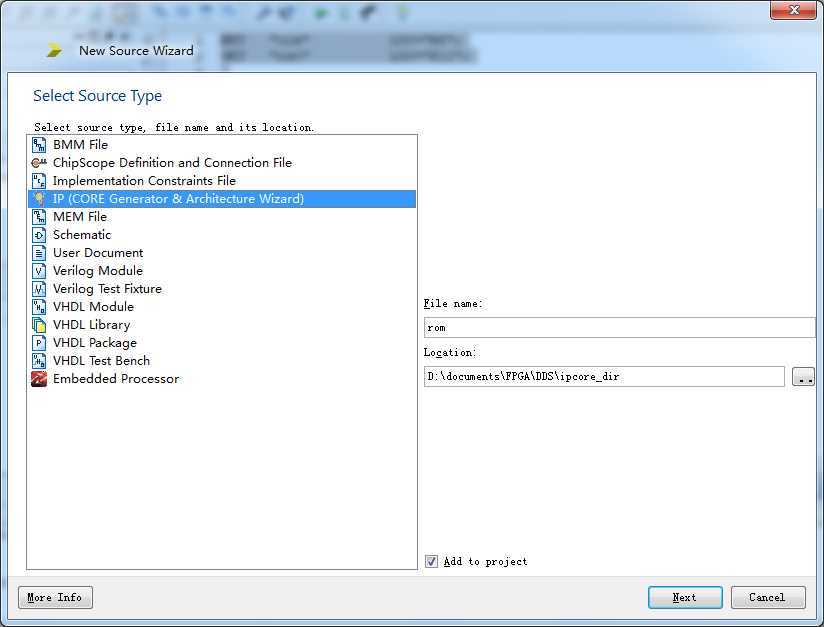
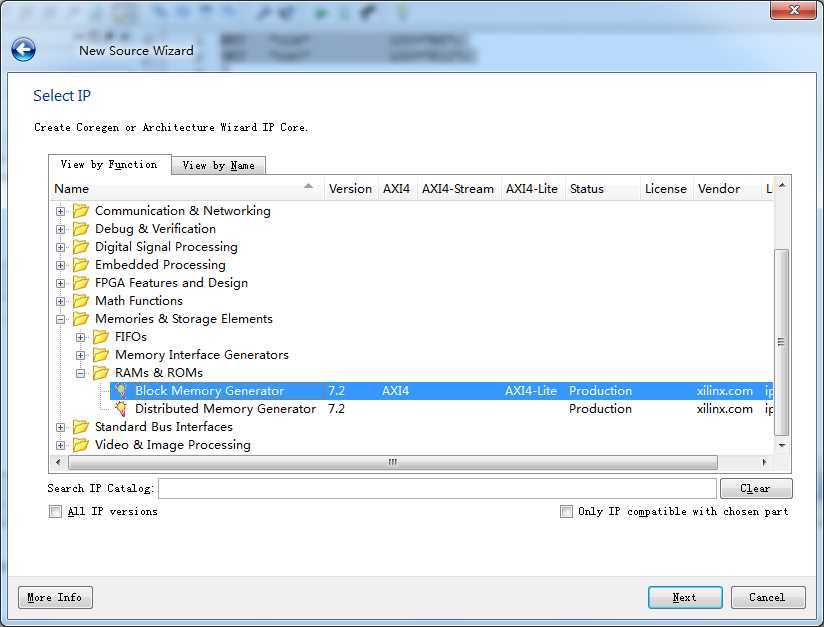
存储类型

存储大小
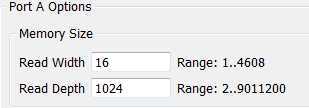
数据初始化

正弦余弦初始化coe文件的生成(使用matlab)
1 clc 2 clear all 3 close all 4 x = linspace(0, 2*pi ,1024); % 在区间[0,2*pi]之间等间隔地取1024个点 5 y_cos = cos(x); 6 y_sin = sin(x); 7 y_cos = y_cos * 2^15; 8 y_sin = y_sin * 2^15; 9 fid = fopen(‘D:/cos.coe‘,‘wt‘); 10 fprintf(fid, ‘%5.0f,\n‘ , y_cos); 11 fclose(fid); 12 fid = fopen(‘D:/sin.coe‘,‘wt‘); 13 fprintf(fid, ‘%5.0f,\n‘ , y_sin); 14 fclose(fid);
用记事本在生成文件开头添加
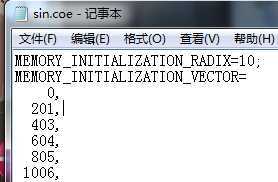
并把最后的结尾换为 ; 号
存储器选项都设置完毕后点击generate即可。
2.4 LED显示(DAC)
1 library IEEE; 2 use IEEE.STD_LOGIC_1164.ALL; 3 use IEEE.STD_LOGIC_ARITH.ALL; 4 use IEEE.STD_LOGIC_UNSIGNED.ALL; 5 use IEEE.STD_LOGIC_SIGNED.ALL; 6 7 entity led is 8 port ( 9 data : IN STD_LOGIC_VECTOR(15 DOWNTO 0); 10 led_seg : OUT STD_LOGIC_VECTOR(7 DOWNTO 0) 11 ); 12 end led; 13 14 architecture Behavioral of led is 15 begin 16 process(data) 17 begin 18 if (signed(data)<-24576) then 19 led_seg<="10000000"; 20 elsif (signed(data)<-16348) then 21 led_seg<="01000000"; 22 elsif (signed(data)<-8192) then 23 led_seg<="00100000"; 24 elsif (signed(data)<0) then 25 led_seg<="00010000"; 26 elsif (signed(data)<8192) then 27 led_seg<="00001000"; 28 elsif (signed(data)<16348) then 29 led_seg<="00000100"; 30 elsif (signed(data)<24576) then 31 led_seg<="00000010"; 32 else 33 led_seg<="00000001"; 34 end if; 35 end process; 36 37 end Behavioral;
2.5 顶层设计TOP
1 library IEEE; 2 use IEEE.STD_LOGIC_1164.ALL; 3 4 entity top is 5 port ( 6 clk : IN STD_LOGIC; 7 rst : IN STD_LOGIC; 8 f_level : IN STD_LOGIC_VECTOR(6 DOWNTO 0); 9 led_seg : OUT STD_LOGIC_VECTOR(7 DOWNTO 0) 10 ); 11 end top; 12 13 architecture Behavioral of top is 14 COMPONENT clock_gen 15 PORT ( 16 clk : IN STD_LOGIC; 17 rst : IN STD_LOGIC; 18 clka : OUT STD_LOGIC 19 ); 20 END COMPONENT; 21 COMPONENT phase_adder 22 PORT ( 23 clka : IN STD_LOGIC; 24 rst : IN STD_LOGIC; 25 f_level : IN STD_LOGIC_VECTOR(6 DOWNTO 0); 26 addr : OUT STD_LOGIC_VECTOR(9 DOWNTO 0) 27 ); 28 END COMPONENT; 29 COMPONENT rom 30 PORT ( 31 clka : IN STD_LOGIC; 32 addra : IN STD_LOGIC_VECTOR(9 DOWNTO 0); 33 douta : OUT STD_LOGIC_VECTOR(15 DOWNTO 0) 34 ); 35 END COMPONENT; 36 COMPONENT led 37 PORT ( 38 data : IN STD_LOGIC_VECTOR(15 DOWNTO 0); 39 led_seg : OUT STD_LOGIC_VECTOR(7 DOWNTO 0) 40 ); 41 END COMPONENT; 42 43 signal clka : STD_LOGIC; 44 signal addr : STD_LOGIC_VECTOR(9 DOWNTO 0); 45 signal data : STD_LOGIC_VECTOR(15 DOWNTO 0); 46 47 begin 48 u1 : clock_gen PORT MAP (clk,rst,clka); 49 u2 : phase_adder PORT MAP (clka,rst,f_level,addr); 50 u3 : rom PORT MAP (clka,addr,data); 51 u4 : led PORT MAP (data,led_seg); 52 53 end Behavioral;
3. 引脚定义
1 NET "clk" LOC="B8"; 2 NET "rst" LOC="P11"; 3 4 NET "f_level<0>" LOC="L3"; 5 NET "f_level<1>" LOC="K3"; 6 NET "f_level<2>" LOC="B4"; 7 NET "f_level<3>" LOC="G3"; 8 NET "f_level<4>" LOC="F3"; 9 NET "f_level<5>" LOC="E2"; 10 NET "f_level<6>" LOC="N3"; 11 12 NET "led_seg<0>" LOC="M5"; 13 NET "led_seg<1>" LOC="M11"; 14 NET "led_seg<2>" LOC="P7"; 15 NET "led_seg<3>" LOC="P6"; 16 NET "led_seg<4>" LOC="N5"; 17 NET "led_seg<5>" LOC="N4"; 18 NET "led_seg<6>" LOC="P4"; 19 NET "led_seg<7>" LOC="G1";
标签:blog http ar io os 使用 sp on 文件
原文地址:http://www.cnblogs.com/connorzx/p/4170161.html